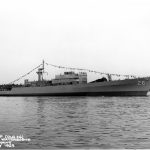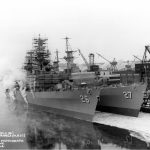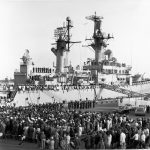USS Belknap , BIW Hull 342, was the lead ship of nine 8,900-ton frigates designed to protect aircraft carriers against aircraft and submarine threats during the Cold War. Five of the class were built at BIW.
Belknap was laid down on Feb. 5, 1962, launched on July 20, 1963, delivered on Nov. 4, 1964, and commissioned three days later. She was named in honor of Rear Admiral George Belknap , who served during the Civil War, and his son, Rear Admiral Reginald Belknap , who served from the Spanish-American War through World War 1.
The ship was classified as a guided missile frigate, DLG 26, at a time when that designation was applied to large, destroyer-type ships. In 1975, when the Navy realigned its ship designation system, she became a guided missile cruiser, CG 26.
Belknap was powered by steam boilers and turbines generating 85,000 horsepower, carrying a primary armament of one Mk10 missile launcher capable of firing Terrier surface-to-air missiles and ASROC anti-submarine rockets. She was also armed with a single five-inch gun and two pairs of three-inch anti-aircraft guns, and was equipped with a small helicopter hangar and flight deck.
In November of 1975 Belknap was involved in a collision with the aircraft carrier John F. Kennedy while the ships were maneuvering at night in the Mediterranean Sea. The damage was severe: Kennedy’s overhanging flight deck crushed the cruiser’s superstructure, while ruptured fuel lines on the carrier spilled jet fuel from above, feeding a raging fire. Seven sailors were killed and the superstructure was entirely destroyed, but the ship was saved by the heroic efforts of her crew and accompanying ships providing firefighting assistance.
The extensive damage required a major reconstruction, and Belknap returned to service in 1980 as one of the most modern ships in the fleet. A few years later she was selected to become the flagship of the 6th Fleet in the Mediterranean. The conversion overhaul, which took place in 1985-1986, included a larger superstructure and transformation of the hangar to provide berthing and working spaces for the 6th Fleet staff.
As Belknap assumed her duties in the 6th Fleet, rapid changes were just ahead. The Berlin Wall fell in 1989, and a few weeks later President George H.W. Bush and Soviet leader Mikhail Gorbachev met at a summit held aboard a cruise ship in Malta. As the fleet flagship, Belknap provided accommodations for President George H.W. Bush and his staff during the summit.
The Malta Summit marked the end of the Cold War and the beginning of a drawdown in U.S. forces. Older cruisers and destroyers were soon decommissioned as their planned replacements – the Arleigh Burke class – came into service. Belknap was the last of her class decommissioned, on February 15, 1995, after 30 years of service. She was sunk as a target a few years later, on September 24, 1998.




